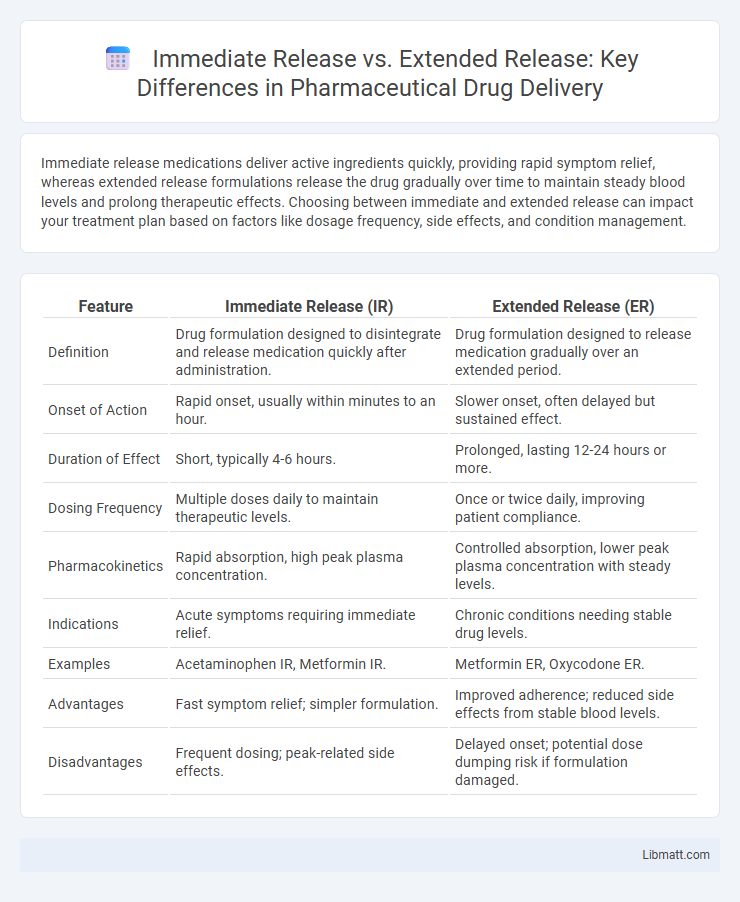Immediate release medications deliver active ingredients quickly, providing rapid symptom relief, whereas extended release formulations release the drug gradually over time to maintain steady blood levels and prolong therapeutic effects. Choosing between immediate and extended release can impact your treatment plan based on factors like dosage frequency, side effects, and condition management.
Table of Comparison
| Feature | Immediate Release (IR) | Extended Release (ER) |
|---|---|---|
| Definition | Drug formulation designed to disintegrate and release medication quickly after administration. | Drug formulation designed to release medication gradually over an extended period. |
| Onset of Action | Rapid onset, usually within minutes to an hour. | Slower onset, often delayed but sustained effect. |
| Duration of Effect | Short, typically 4-6 hours. | Prolonged, lasting 12-24 hours or more. |
| Dosing Frequency | Multiple doses daily to maintain therapeutic levels. | Once or twice daily, improving patient compliance. |
| Pharmacokinetics | Rapid absorption, high peak plasma concentration. | Controlled absorption, lower peak plasma concentration with steady levels. |
| Indications | Acute symptoms requiring immediate relief. | Chronic conditions needing stable drug levels. |
| Examples | Acetaminophen IR, Metformin IR. | Metformin ER, Oxycodone ER. |
| Advantages | Fast symptom relief; simpler formulation. | Improved adherence; reduced side effects from stable blood levels. |
| Disadvantages | Frequent dosing; peak-related side effects. | Delayed onset; potential dose dumping risk if formulation damaged. |
Understanding Immediate Release and Extended Release
Immediate Release (IR) medications deliver active ingredients rapidly, providing quick relief by dissolving soon after ingestion. Extended Release (ER) formulations release the drug slowly over time, maintaining consistent blood levels and reducing the dosing frequency. Understanding these differences helps you choose the appropriate medication form for effective symptom management and improved adherence.
Key Differences Between Immediate and Extended Release
Immediate release (IR) medications deliver the active ingredient rapidly into the bloodstream for quick symptom relief, typically requiring multiple doses per day. Extended release (ER) formulations release the drug slowly over an extended period, maintaining steadier blood levels and reducing dosing frequency. Understanding these key differences helps optimize your treatment plan by balancing onset speed with duration of effect.
How Immediate Release Medications Work
Immediate release medications dissolve quickly after ingestion, allowing the active drug to enter the bloodstream rapidly for fast therapeutic effects. They typically require multiple doses throughout the day to maintain consistent drug levels due to their short duration of action. This rapid absorption is ideal for conditions needing prompt symptom relief, such as pain or acute infections.
How Extended Release Medications Work
Extended release medications are designed to release the active ingredient gradually over an extended period, maintaining consistent drug levels in the bloodstream. This mechanism reduces the frequency of dosing compared to immediate release formulations, which release the drug quickly and require multiple doses throughout the day. The controlled release technology often involves specialized coatings or matrix systems that dissolve or degrade at a specific rate to ensure steady absorption.
Benefits of Immediate Release Formulations
Immediate Release (IR) formulations provide rapid absorption, allowing for quick symptom relief, which is essential for acute conditions or pain management. These medications offer precise control over dosing schedules since they act faster and are eliminated more quickly from the body. Your treatment can be easily adjusted with IR medications, as they allow for flexibility in timing and dosage based on immediate needs.
Advantages of Extended Release Formulations
Extended release formulations provide sustained drug delivery, maintaining consistent therapeutic levels over an extended period and reducing the frequency of dosing. This improved drug adherence enhances treatment efficacy and minimizes fluctuations in blood concentration, which can reduce side effects. Your medication routine becomes more convenient, supporting better management of chronic conditions and overall patient compliance.
Common Uses for Immediate vs Extended Release
Immediate release formulations are commonly used for rapid symptom relief in conditions like acute pain, allergies, and infections where fast absorption is critical. Extended release formulations serve chronic conditions such as diabetes, hypertension, and depression by maintaining consistent drug levels over time to improve patient compliance and reduce dosing frequency. Choosing between immediate and extended release depends on the therapeutic goal, drug pharmacokinetics, and patient-specific factors.
Potential Side Effects and Risks
Immediate release medications cause rapid absorption, potentially leading to peak concentration side effects such as dizziness, nausea, or increased heart rate. Extended release formulations provide a slower, steadier drug release, which may reduce the severity of side effects but increase the risk of drug accumulation and toxicity if not properly dosed. Both forms carry risks of allergic reactions, gastrointestinal issues, and interactions with other medications, requiring careful patient monitoring.
Choosing the Right Release Formulation
Selecting the right release formulation depends on your medical needs and lifestyle preferences. Immediate release medications deliver active ingredients quickly for rapid symptom relief, while extended release formulations provide a steady drug release over time, reducing dosing frequency and maintaining consistent blood levels. Consulting your healthcare provider ensures the optimal balance between efficacy, convenience, and side effect management tailored to your condition.
Frequently Asked Questions on Release Types
Immediate Release (IR) medications dissolve quickly, delivering the active ingredient rapidly into your bloodstream for fast relief, while Extended Release (ER) formulations are designed to release the drug gradually over time for sustained effect. Common questions often focus on dosing frequency, with IR requiring multiple doses per day versus ER's once or twice daily schedule, and potential differences in side effects due to blood concentration levels. Understanding these distinctions helps you optimize treatment effectiveness and adherence based on your medical needs.
Immediate Release vs Extended Release Infographic

 libmatt.com
libmatt.com